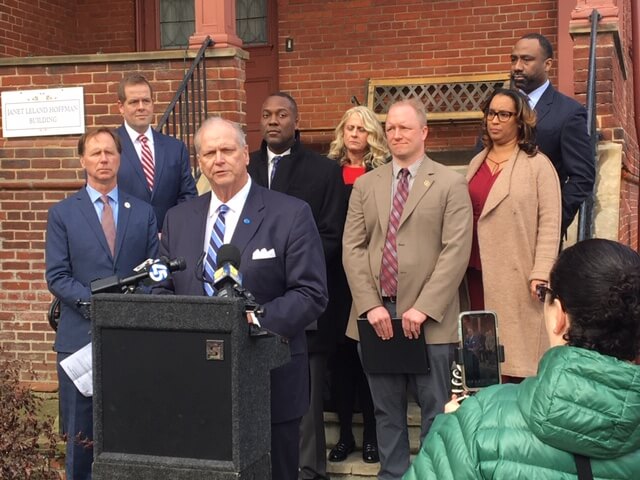‘We Have to Get Things Moving’: Baltimore-Area Leaders Urge Transit Boost

State spending on transportation favors roads over transit, and the Washington, D.C., area over the Baltimore region, advocates for the Baltimore area complained on Wednesday.
At a news conference outside the State House, representatives from the city and surrounding counties urged the legislature to support a bill that would require the state Department of Transportation to dramatically boost spending on bus and rail projects.
Senate Bill 424 and House Bill 368 would require the state to allocate at least $500 million to the Maryland Transit Administration for capital projects in each of the next five years. MTA capital funding in the state’s rolling six-year Capital Transportation Program has averaged $370 million annually in recent years.
The bills would mandate a boost in operating revenues as well.
The Hogan administration is urging the legislature to reject the measures. In a letter to lawmakers, MDOT said the bills would require the agency to redirect funds from other projects throughout the state.
The transportation advocates who gathered in Annapolis on Wednesday said increased spending on transit is necessary to correct what they called an imbalance in MDOT’s allocation of resources.
“There’s only been a 2% increase in spending in the MTA” since the General Assembly approved an increase in the gas tax, said Donald C. Fry, president of the Greater Baltimore Committee, a business group.
“Contrast that to the State Highway Administration, that’s seen a 77% increase since the fiscal year 2013. This would help us get some projects in the pipeline.”
Howard County Executive Calvin Ball (D) and Anne Arundel County Executive Steuart Pittman (D) said increased spending on transit would make it easier for people to get to work and would help the environment. Top transportation officials from Baltimore City and Baltimore County also spoke in favor of the legislation, which is being sponsored by Sen. Craig J. Zucker (D-Montgomery) and Del. Brooke E. Lierman (D-Baltimore City).
“We need both a well-run and adequately-funded system if we want to improve the quality of life and opportunities for all of our residents and our businesses,” said Ball.
He added that “losing over $2.5 million in state funds… to plan and design capital improvements along the U.S. Route 29 corridor between Columbia and Montgomery County isn’t the way we wanted to start this legislative session.”
Pittman said Anne Arundel is attempting to minimize “suburban sprawl” by favoring transit-oriented development. But that can only occur if people who wish to leave their cars at home can do so, he said.
“When we’re talking about state investments, we have to put a stake in the ground,” Pittman told reporters, acknowledging — as others did — that the transit request comes as lawmakers search for a way to fund a multibillion-dollar recommendation for increased spending on education.
Since becoming governor, Hogan has signed off on plans to build the Purple Line, a light rail system that will connect Montgomery and Prince George’s counties. He helped broker a historic funding agreement for the Washington, D.C., region’s transit system. And he has proposed an ambitious $11 billion project to widen two major highways in the capital region.
He also killed a proposed rail line in Baltimore City that had qualified for nearly $1 billion in federal funds, calling it a “boondoggle.”
“There’s certainly a feeling from our perspective that you see a lot of the major projects occurring in the Washington area,” said Fry, a former state lawmaker from Harford County.
The Zucker/Lierman bills would not grow the state’s Transportation Trust Fund. Instead, they would require MDOT to divert funds from other projects, according to a legislative analysis.
To meet the bill’s mandated appropriations, MDOT would have to redirect between $74 million and $175 million annually over the next five years, a total of $523 million.
In their letter to the legislature, Heather Murphy, MDOT’s Director of Planning and Capital Programming, and Jeff Tosi, the agency’s Director of Government Affairs, said the proposal to boost transit spending would cause delays in other projects, jeopardize traveler safety, put federal dollars at risk, and take monies from other agencies, such as the Port of Baltimore and the Motor Vehicles Administration.
“There are currently unfunded capital needs throughout MDOT’s statewide network,” they wrote. “Shifting this large amount of funding from the other [agencies] to MTA would have a substantial impact on the MDOT capital program and could result in significant reductions to system preservation and an ability to address serious safety deficiencies.”
David Broughton, an MDOT spokesman, said the Hogan administration has allocated “record” funding for transit, including projects “that have been in the works for decades.”
He said the recently-completed Cornerstone Plans will help identify “the next generation of transit projects,” and he noted that the Central Maryland Regional Transit Plan Commission is working “on the 25-year vision for transit in the Baltimore region.”
But critics maintain the pipeline has already run dry.
Last year, MDOT published its first-ever “capital needs inventory,” a report demanded by the legislature to create a catalogue of maintenance needs over the next decade.
Fry said the report’s $4.6 billion shortfall was inexcusable. “It’s just incredulous to us that you see that sort of cut being made at the time where the needs have been so well-expressed and the funding is so inadequate.”
He also referenced a Maryland Matters report this week in which the state’s congressional delegation expressed concern that a failure to plan is hampering their ability to advocate for federal transit funds at a crucial time.
“You see at the national level, our congressional representatives are expressing concern that there are no transit plans in the pipeline at the time that the federal government is about to reallocate a federal transportation plan,” he said. “So we have to get things moving.”




 Creative Commons Attribution
Creative Commons Attribution